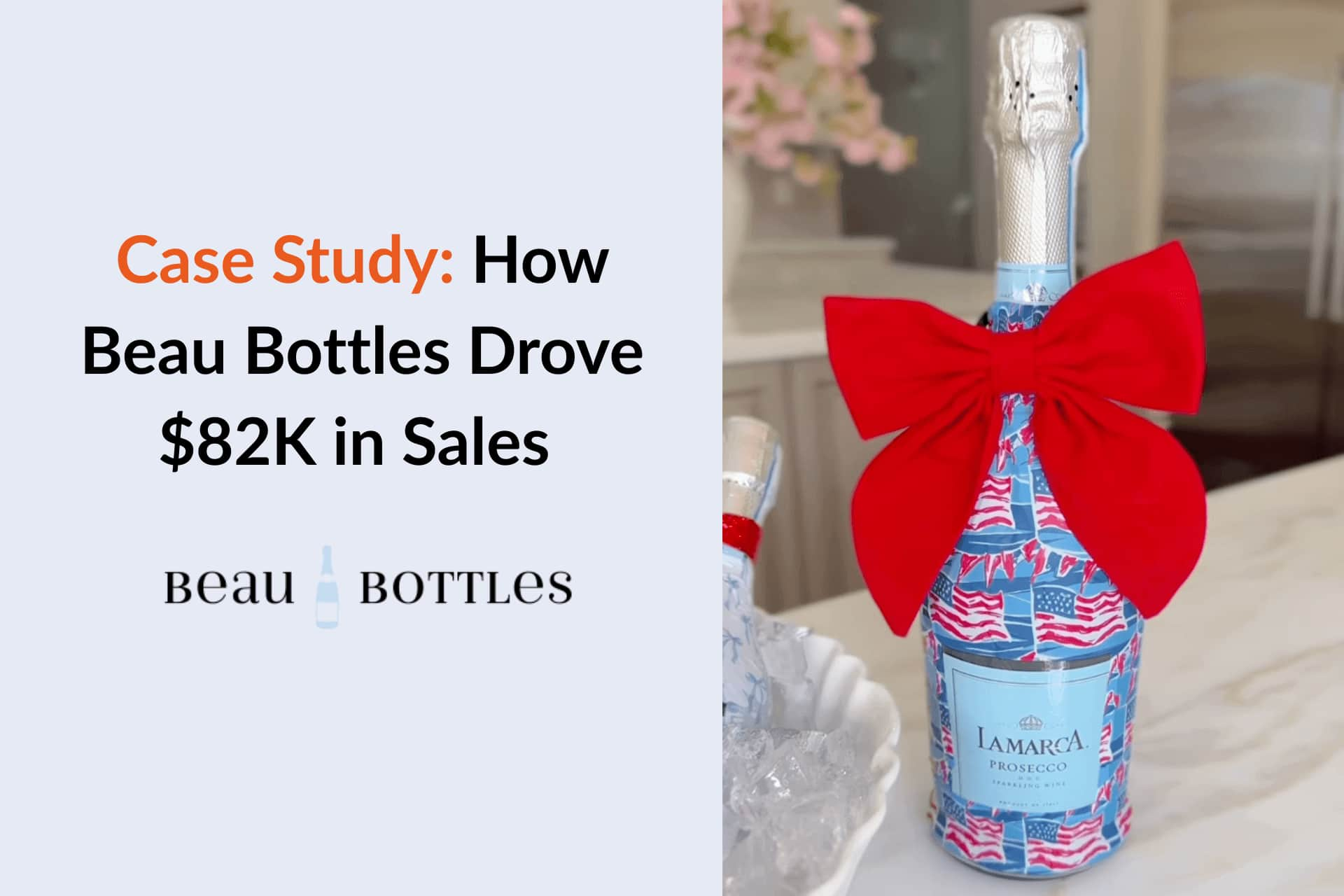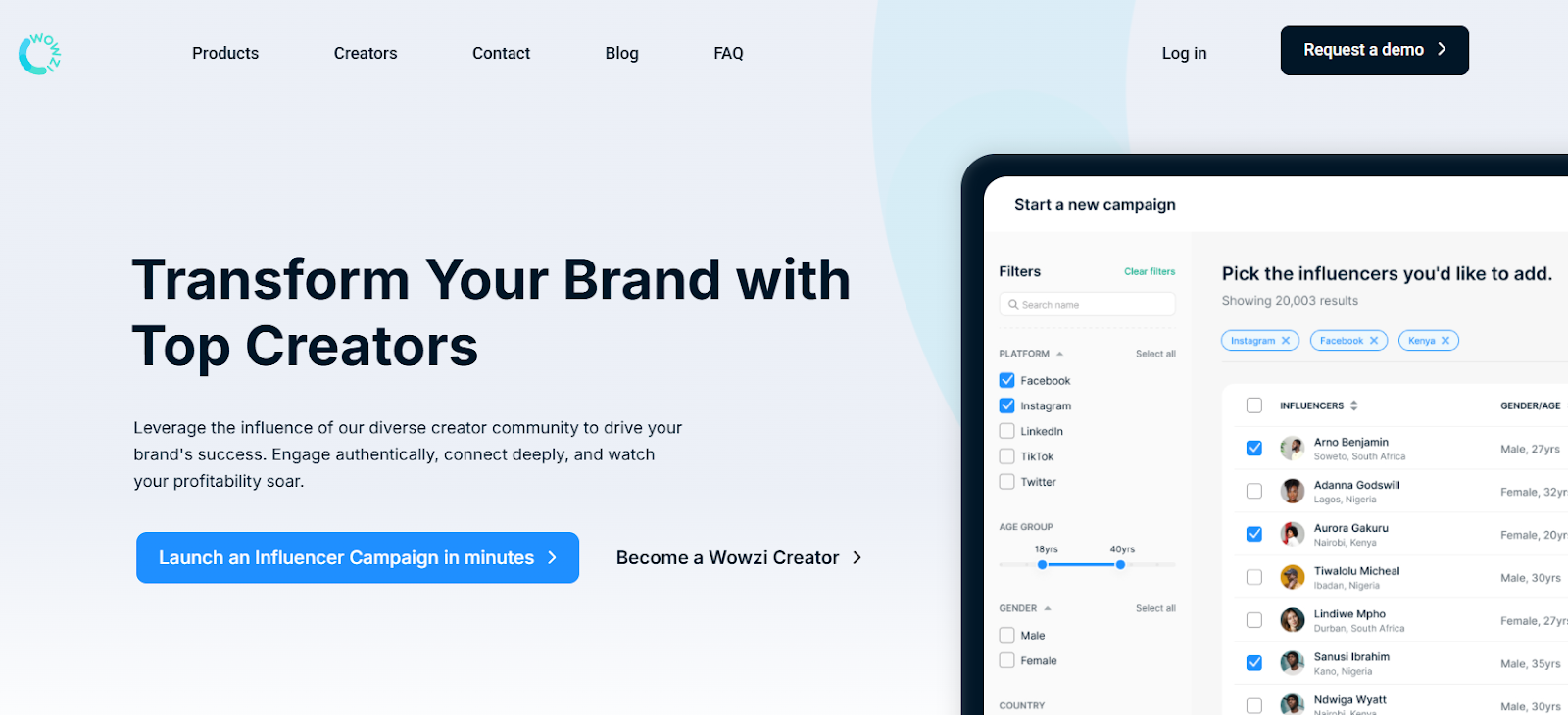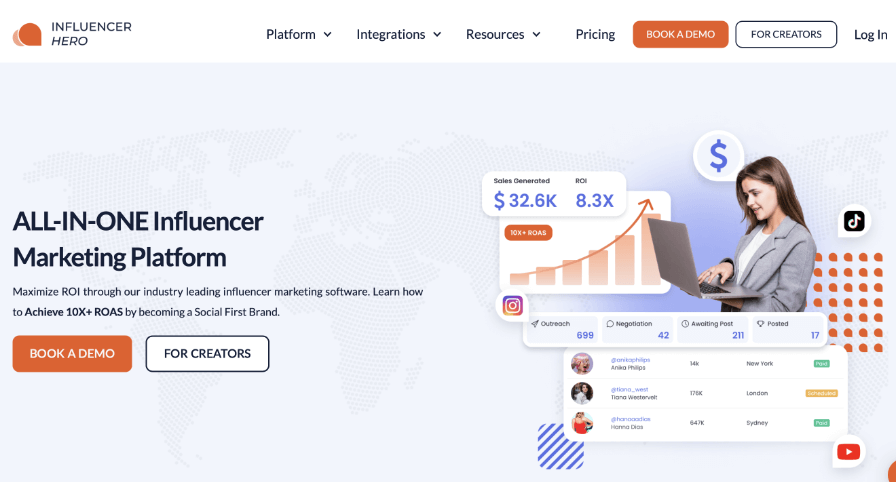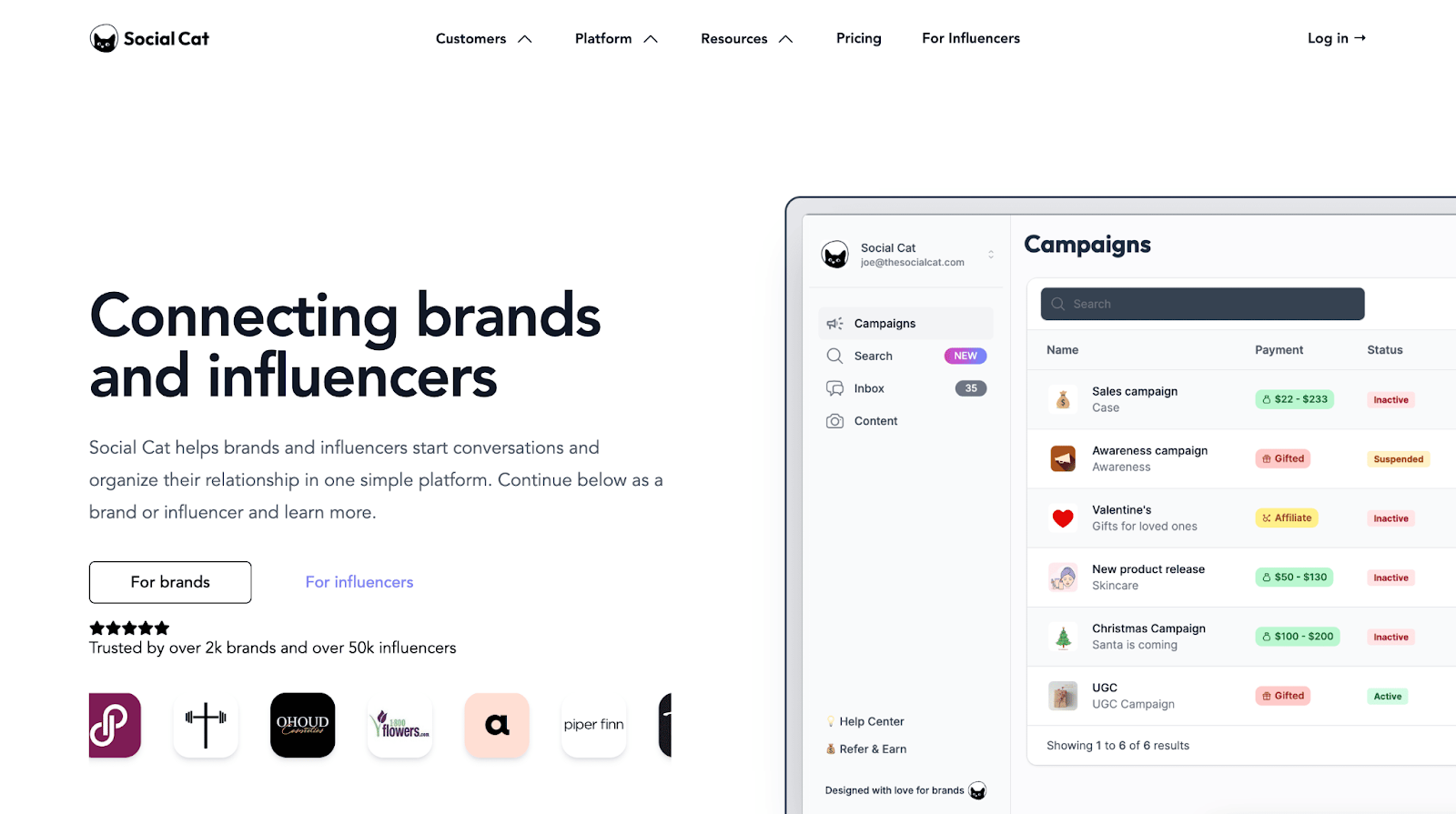





Wowzi is a specialized influencer marketing platform designed to streamline the process of carrying out influencer campaigns. Offering features like AI-powered creator discovery, in-app content approvals, and real-time campaign tracking, Wowzi provides an all-in-one solution for managing influencer marketing programs.
However, while Wowzi excels in creator discovery for the African region and campaign management, brands seeking a comprehensive influencer marketing solution might find its capabilities limited.
The influencer marketing landscape continues to expand, with a recent report from Statista projecting the global influencer marketing industry to reach $33 billion by the end of 2025, reflecting a 36% year-over-year growth. This growth underscores the importance of selecting the right platform to effectively engage with audiences and drive brand success.
Top 10 Wowzi Alternatives
While Wowzi provides brands with access to Africa’s largest verified creator library and AI-powered discovery tools, the platform does have limitations—particularly for teams looking for more transparent pricing, stronger customer support, and easier onboarding for new users.
Wowzi does not publicly disclose its commission fees, leaving brands uncertain about the exact costs of running campaigns. It’s also unclear whether fees apply to creator earnings or the total campaign spend, which may be a drawback for companies needing budget predictability.
According to user feedback, Wowzi could provide more structured workflows and onboarding guidance. For teams new to influencer marketing platforms, this steep learning curve can slow down campaign execution.
Wowzi’s strongest creator network is based in Africa, making it highly effective for region-specific campaigns. However, brands prioritizing North American or European markets may find its global coverage less competitive compared to other platforms with broader reach.
Some users have reported inconsistent support, with slower response times and limited assistance for complex campaign setups. For agencies managing multi-brand or international campaigns, this could present challenges in keeping projects on track.
To compare the different platforms, we focused on central criteria that all must meet:

Platform Coverage: Instagram, TikTok, and YouTube
Best For: Brands and agencies looking to activate African creators at scale, with access to verified profile data, AI-powered discovery, and audience insights. Particularly suited for companies running multi-country or multi-brand campaigns that need creator vetting, live tracking, and in-app content approval workflows.
Pricing: Wowzi is free to sign up. Brands only pay when they launch a campaign, which includes a commission fee charged by Wowzi. However, the commission percentage is not publicly disclosed, and it’s unclear whether it applies to total campaign spend or creator earnings—something brands may find restrictive.
Review: 4.2/5.0 (Glassdoor employee & user feedback)
Ease of Use (UX/UI): Wowzi provides a robust suite of AI-powered tools for discovery and campaign tracking, but some users report a steep learning curve and limited guidance during onboarding. Its workspace “Clusters” make managing campaigns across multiple regions easier, though first-time users may need extra support.
Customer Support: Wowzi offers platform support but feedback indicates gaps in response times and assistance for more complex campaign setups.

Platform Coverage: Influencer Hero supports influencer marketing across Instagram, TikTok, YouTube, Facebook, Pinterest, Snapchat, X (Twitter), and Twitch.
Best For: Influencer Hero is best for fast-scaling DTC brands and eCommerce businesses on Shopify, WooCommerce, or custom setups looking to run high-volume influencer, affiliate, and UGC campaigns from a single dashboard.
Pricing: Influencer Hero offers flexible monthly plans:
Reviews: 5.0 / 5.0 on Capterra
Ease of use (UX/UI): The interface is designed for quick campaign setup, with process maps and workflows that streamline execution. Even new users can become comfortable quickly, reducing onboarding time.
Customer support: Influencer Hero provides around-the-clock assistance via chat, email, and a rich knowledge library. Every subscription includes a personal account manager, and premium tiers unlock a private Slack channel and regular strategic check-ins for ongoing optimization.
Wowzi does not publicly disclose pricing, relying on an opaque service fee structure, compared to Influencer Hero’s $649/month (Standard) up to $2,490/month (Business), reflecting a difference between cost-efficient affiliate automation and full-scale influencer campaign management.
Both platforms allow tracking of creator performance, but Influencer Hero emphasizes live reporting, Shopify/WooCommerce integrations, and personal account managers, while Wowzi streamlines setup and affiliate tracking for smaller programs. This makes Wowzi ideal for startups seeking simplicity, while Influencer Hero better suits fast-scaling DTC brands managing thousands of influencers.
For teams prioritizing budget transparency, Wowzi’s undisclosed fees may be a drawback, whereas Influencer Hero’s pricing clearly reflects extensive platform coverage, high-volume support, and multi-channel campaign capabilities. Brands must balance cost against scale, as Influencer Hero delivers broader influencer management.

Platform coverage: Instagram, YouTube and TikTok. Limited functionality for influencers from Snapchat and X.
Pricing: Modash pricing starts at $199 per month. They also offer a medium tier plan fixed at a $499 rate. The enterprise level plan has custom pricing.
Reviews: 4.9/5.0 (Capterra)
Ease of Use (UX/UI): Optimized for rapid influencer discovery with smooth-loading filters and a simple interface. Users can begin exploring campaigns almost immediately without formal onboarding.
Customer Support: Offers email support for all users, with live chat and priority response for higher-tier plans. Tutorials and a growing knowledge base help users onboard efficiently.
Wowzi does not disclose its pricing publicly, which contrasts with Modash’s $199/month entry-level plan and $499 mid-tier, highlighting the difference between lean affiliate automation and analytics-driven influencer discovery. Wowzi emphasizes program setup, payout automation, and branded affiliate portals, while Modash provides advanced audience vetting, pipeline organization, and API integrations.
Both platforms track performance, but Modash offers real-time post monitoring, credibility scoring, and structured campaign pipelines, whereas Wowzi simplifies workflows and commission tracking for smaller teams. This positions Wowzi for cost-conscious startups, and Modash for brands seeking more control and insights in influencer selection.
From a budget perspective, Wowzi’s opaque pricing may make cost planning difficult, while Modash’s tiers provide predictable access to discovery and analytics features. Brands must weigh transparency against functionality, as Modash offers deeper influencer insights while Wowzi streamlines affiliate operations.

Platform Coverage: Instagram, TikTok, and YouTube.
Best For: Social media teams needing advanced scheduling, performance measurement, and listening capabilities integrated with influencer collaboration.
Pricing: Sprout Social starts at $1,599 per user/month, $600/month for additional users; billed monthly or annually with a required 12-month contract.
Reviews: 4.5/5.0 (Capterra)
Ease of Use (UX/UI): Clean and intuitive dashboard centralizes publishing, engagement, and analytics across platforms. Teams can navigate scheduling and reporting without significant onboarding.
Customer Support: Offers email, chat, and phone assistance; higher-tier plans get a dedicated success manager. Support helps with platform adoption and campaign troubleshooting.
Wowzi’s pricing is undisclosed, unlike Sprout Social’s $1,599/month per user base plan, illustrating the gap between simple affiliate automation and enterprise-grade social management. Wowzi focuses on affiliate and referral program automation, whereas Sprout Social provides advanced scheduling, analytics, social listening, and team workflow management.
Both platforms monitor performance, but Sprout Social emphasizes consolidated inboxes, custom reporting dashboards, and real-time social insights, while Wowzi streamlines affiliate payouts and program setup for smaller teams. This makes Wowzi attractive to startups seeking lean automation, and Sprout Social ideal for social teams managing multiple channels with detailed metrics.
The lack of public pricing makes Wowzi less transparent for budget-conscious brands, while Sprout Social’s high cost reflects its enterprise-level tools and support. Brands must balance simplicity with feature depth, as Sprout Social offers more advanced social collaboration, whereas Wowzi focuses on affordability and ease of use.

Platform coverage: Upfluence covers Instagram, TikTok, YouTube, X, Twitch, Pinterest, and WordPress blogs.
Pricing:
Reviews: 4.6/5.0 (G2)
Best For: E-commerce brands and agencies looking to scale YouTube influencer outreach and track ROI.
Ease of Use (UX/UI): Built for full-scale influencer marketing with a slightly steeper learning curve. The interface is comprehensive, ideal for experienced teams handling large campaigns.
Customer Support: Provides onboarding sessions, dedicated account managers for higher-tier plans, and responsive live chat/email support.
Wowzi does not disclose its pricing, which contrasts with Upfluence’s $1,276/month standard plan or $14,406/year annual payment, highlighting the difference between small-scale affiliate automation and enterprise influencer management. Wowzi focuses on automated payouts, commission tracking, and branded affiliate portals, whereas Upfluence provides large influencer databases, affiliate link tracking, and centralized campaign management.
Both platforms track creator performance, but Upfluence emphasizes real-time analytics, ecommerce integration, and fraud detection, while Wowzi simplifies program setup and payout flows for smaller teams. This makes Wowzi suitable for startups wanting lean automation, and Upfluence ideal for e-commerce brands or agencies scaling YouTube influencer outreach.
For brands concerned about pricing clarity, Wowzi’s undisclosed fees are a drawback, whereas Upfluence’s pricing reflects its enterprise-grade capabilities and support. Teams must weigh transparency against scale, as Upfluence delivers advanced tools while Wowzi excels in cost-efficient automation.

Platform coverage: Captiv8 covers Instagram, TikTok, Facebook, YouTube, X (formerly Twitter) and Twitch.
Pricing: $25.000 Annually (Annual commitment needed). Plus a $3.000 onboarding fee.
Reviews: 4.5/5.0 (G2)
Best for: Brands and agencies running large-scale influencer campaigns in platforms like Instagram, TikTok and YouTube.
Ease of Use (UX/UI): Comprehensive platform with robust tools for seasoned marketers. First-time users may require time to navigate and understand all features fully.
Customer Support: Offers personalized onboarding, campaign guidance, and dedicated account managers. Some users report slower response times for urgent queries or billing concerns.
Wowzi keeps its pricing undisclosed, while Captiv8 charges $25,000 annually with an additional $3,000 onboarding fee, requiring a yearly commitment. This makes Captiv8 more transparent in cost but also places it in the mid-to-enterprise tier of influencer platforms.
Captiv8 supports influencer activations across Instagram, TikTok, Facebook, YouTube, X (formerly Twitter), and Twitch, offering broader platform coverage than Wowzi. Its features extend into influencer discovery, content approval workflows, and campaign reporting, while Wowzi focuses narrowly on affiliate automation and branded referral portals.
For startups and SaaS businesses, Wowzi provides a simpler, more specialized solution for managing affiliates. For larger brands with a multichannel influencer presence, Captiv8’s wider coverage and structured pricing model may be the stronger fit.

Platform Coverage: CreatorIQ supports Instagram, TikTok, YouTube, Facebook, Pinterest, Twitch, and X (Twitter).
Pricing: CreatorIQ pricing is divided into 4 tiers:
An optional “Creator Connect” feature available for an additional $15,000 per yea
Reviews: 4.6/5.0 (G2)
Best For: Large-scale brands that require robust data controls, customizable workflows, and in-depth influencer analytics across international markets.
Ease of Use (UX/UI): Clean interface designed for team collaboration across campaigns. Workflow efficiency supports large-scale, multi-market campaigns.
Customer Support: Expert onboarding, dedicated account managers, and ongoing strategy guidance. Support ensures campaigns are optimized and meet KPIs.
Wowzi does not disclose its pricing, while CreatorIQ offers four structured tiers starting at $35,000 per year for the Basic plan and going up to $200,000 per year for Enterprise, depending on the number of creators and seats. This positions CreatorIQ clearly as an enterprise solution, whereas Wowzi caters to startups and SaaS companies with simpler affiliate management tools.
CreatorIQ provides end-to-end influencer marketing with features like large-scale discovery, global campaign orchestration, and advanced analytics. By contrast, Wowzi focuses on branded affiliate portals, automated payouts, and commission tracking, prioritizing simplicity over enterprise breadth.
For brands with the budget and need for advanced influencer data, CreatorIQ stands out as a market leader, but its steep pricing may be out of reach for smaller teams. Wowzi offers a leaner entry point for companies focused primarily on affiliate program automation.

Platform Coverage: HypeAuditor supports Instagram, TikTok, YouTube, Twitch, X (Twitter), and Snapchat.
Pricing: Flexible usage-based pricing, with Business plans starting at around $10,000/year and Enterprise reaching up to $60,000/year.
Reviews: 4.6/5.0 (G2)
Best For: Teams that prioritize data accuracy, detecting fraudulent activity, and benchmarking competitors across various influencer platforms.
Ease of Use (UX/UI): Modern interface designed for marketing professionals. Advanced tools require some training for full utilization.
Customer Support: Provides onboarding, live chat, email assistance, and a comprehensive knowledge base. Support ensures teams can quickly leverage insights for campaigns.
Wowzi does not disclose its pricing publicly, charging a service fee that remains unclear, while HypeAuditor offers entry plans starting at $10.000/year with tiered access to its analytics and fraud detection tools. This highlights a difference between Wowzi’s workflow-focused services and HypeAuditor’s data-driven emphasis on influencer credibility and audience analysis.
HypeAuditor excels in AI-powered fraud detection and detailed reporting, making it a strong choice for brands that prioritize transparency and data accuracy. Wowzi, meanwhile, streamlines influencer connections and commission workflows, appealing to companies that value execution over deep analytics.
From a cost perspective, HypeAuditor’s pricing provides a transparent structure for brands to align budgets with analytics depth, while Wowzi’s lack of disclosed fees creates uncertainty. Ultimately, HypeAuditor fits businesses needing verified insights, while Wowzi caters to cost-conscious teams prioritizing reach and campaign execution.

Platform Coverage: Instagram, TikTok, YouTube, X (formerly Twitter), Twitch, and Snapchat.
Pricing: GRIN’s yearly pricing starts at $25.000, with monthly payments available at $2.085/month. No discounts for upfront payments.
Best For: Best suited for DTC brands looking to centralize influencer relationship management in one streamlined system.
Reviews: 4.5/5.0 (G2)
Ease of Use (UX/UI): Intuitive and simple for campaign management. May slow down with large influencer sets or batch processing.
Customer Support: Offers onboarding, email, and chat support; premium customers receive dedicated strategists. Support quality may vary.
Wowzi does not disclose its pricing publicly, instead charging a service fee without transparency, which contrasts with GRIN’s pricing starting at $2085/month. GRIN emphasizes Shopify and WooCommerce integrations alongside influencer relationship management, while Wowzi focuses more on connecting brands with micro and nano influencers in emerging markets.
Both platforms enable campaign management and performance tracking, but GRIN delivers advanced integrations and influencer relationship workflows, whereas Wowzi simplifies operations with a lighter approach. This makes GRIN better suited for mid-market and enterprise brands with structured influencer strategies, while Wowzi appeals to smaller teams looking for easier execution.
From a budget perspective, Wowzi’s opaque service fee model makes it harder for brands to forecast costs, while GRIN’s premium structure provides more predictability at a higher investment. Companies must weigh cost transparency and integration depth when deciding between the two.

Platform Coverage: Instagram, TikTok, YouTube, Twitter, and Facebook.
Pricing:
Best for: Small businesses and emerging brands looking for a budget-friendly, intuitive influencer marketing solution with built-in CRM and AI-powered influencer discovery. Well-suited for lean teams expanding their influencer marketing without enterprise complexity.
Reviews: 4.6/5.0 (G2)
Ease of Use (UX/UI): The platform features a straightforward layout that helps new users set up campaigns quickly. However, the free plan comes with restrictions that limit scalability for higher-volume marketers.
Customer Support: Users get access to basic onboarding and email support. More detailed or ongoing assistance is only available at higher subscription tiers.
Wednesday.App offers tiered pricing with a free plan and paid tiers starting at $79/month, compared to Wowzi, which does not publicly disclose its service fees. Wednesday.App emphasizes AI-assisted influencer discovery, integrated messaging, and team collaboration, whereas Wowzi focuses on automating affiliate payouts, commission flows, and branded portals.
Both platforms help manage campaigns, but Wednesday.App provides built-in CRM, mass email outreach, and ChatGPT-powered automation, while Wowzi streamlines commission tracking, program setup, and payout management for startups. This positions Wednesday.App for small teams needing AI-driven influencer management, and Wowzi for early-stage SaaS brands looking for lean affiliate program solutions.
From a budgeting perspective, Wednesday.App’s free and low-cost tiers allow experimentation and team collaboration without major upfront costs, whereas Wowzi’s undisclosed pricing may complicate financial planning. Brands must weigh transparency and AI-enabled discovery against simple, cost-efficient affiliate program automation.

Platform Coverage: Instagram and TikTok, with a focus on micro and nano influencers for visually-driven campaigns.
Best for: Small to medium-sized brands launching or scaling influencer marketing with straightforward tools without enterprise complexity.
Pricing:
Review: 4.3/5.0 (Trustpilot)
Ease of Use (UX/UI): Beginner-friendly interface designed for straightforward campaign management and influencer collaboration.
Customer Support: Email support available for all plans, with priority assistance for Pro subscribers.
SocialCat has clear monthly pricing starting at $99/month for Essentials, with higher tiers at $199 and $299, while Wowzi does not reveal its fees, highlighting a contrast between cost-predictable influencer management tools and opaque affiliate SaaS programs. SocialCat is designed for small to medium brands focusing on Instagram and TikTok campaigns, whereas Wowzi provides streamlined affiliate and referral program automation across various SaaS platforms.
Both platforms simplify campaign operations, but SocialCat offers in-app influencer onboarding, centralized messaging, content rights management, and basic analytics, while Wowzi automates payouts, commission flows, and affiliate portal setup. This makes SocialCat suitable for brands prioritizing social media influencer campaigns, and Wowzi for startups wanting a lean affiliate management solution.
From a budget perspective, SocialCat’s tiered plans allow small teams to scale campaigns predictably, while Wowzi’s undisclosed fees may pose challenges in planning and cost transparency. Brands must balance the predictability of SocialCat’s pricing and social campaign focus against Wowzi’s efficient affiliate program automation.
Wowzi serves as a streamlined platform for brands and agencies focused on activating African creators efficiently, offering AI-powered discovery, verified profile data, and audience insights. Its strengths lie in campaign tracking, in-app approvals, and customizable workspaces, making it ideal for teams managing multi-country or multi-brand campaigns without heavy manual processes.
For brands that require more transparent pricing, broader influencer discovery across global markets, or advanced CRM features, platforms like Influencer Hero provide expanded capabilities. Wowzi’s focus on flexible, commission-based activation makes it particularly well-suited for startups and lean teams prioritizing operational efficiency and scalable African creator campaigns.

Wowzi is best suited for brands and agencies aiming to activate African creators at scale, with a focus on multi-country or multi-brand campaigns. Companies seeking verified creator profiles, AI-powered discovery, and in-app content approvals will find it particularly useful.
The platform offers powerful AI-driven tools and customizable workspaces, but some users report a steep learning curve and limited onboarding guidance. Teams new to influencer management may need extra time to navigate discovery, approvals, and live campaign tracking effectively.
Absolutely. Platforms like Influencer Hero offers competitive pricing while still including a robust set of features such as influencer discovery, campaign management, and analytics. Influencer Hero is also known for its affordability and focus on influencer discovery, making it a great option for startups and small businesses.
Influencer Hero provides multi-platform influencer discovery, built-in CRM, and automated campaign workflows across Instagram, TikTok, YouTube, and more. Brands looking for global reach, scalable pricing, and deeper ecommerce integrations may find it a more comprehensive solution than Wowzi’s Africa-focused platform.
Yes, many Wowzi alternatives offer specialized features for TikTok influencer marketing, acknowledging the platform's growing influence. Influencer Hero and Grin are excellent choices for businesses looking to leverage TikTok's dynamic content and wide-reaching influence. These platforms provide targeted discovery tools and campaign management features designed to maximize engagement on TikTok.



Schedule a Demo with one of our media experts below.